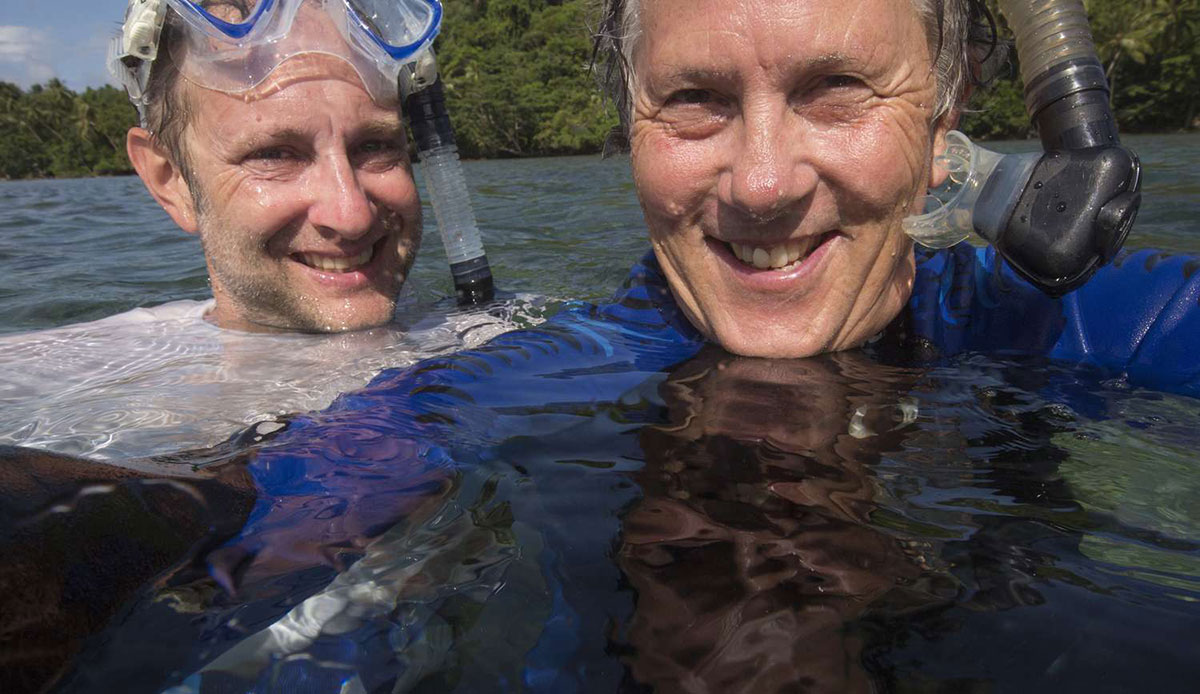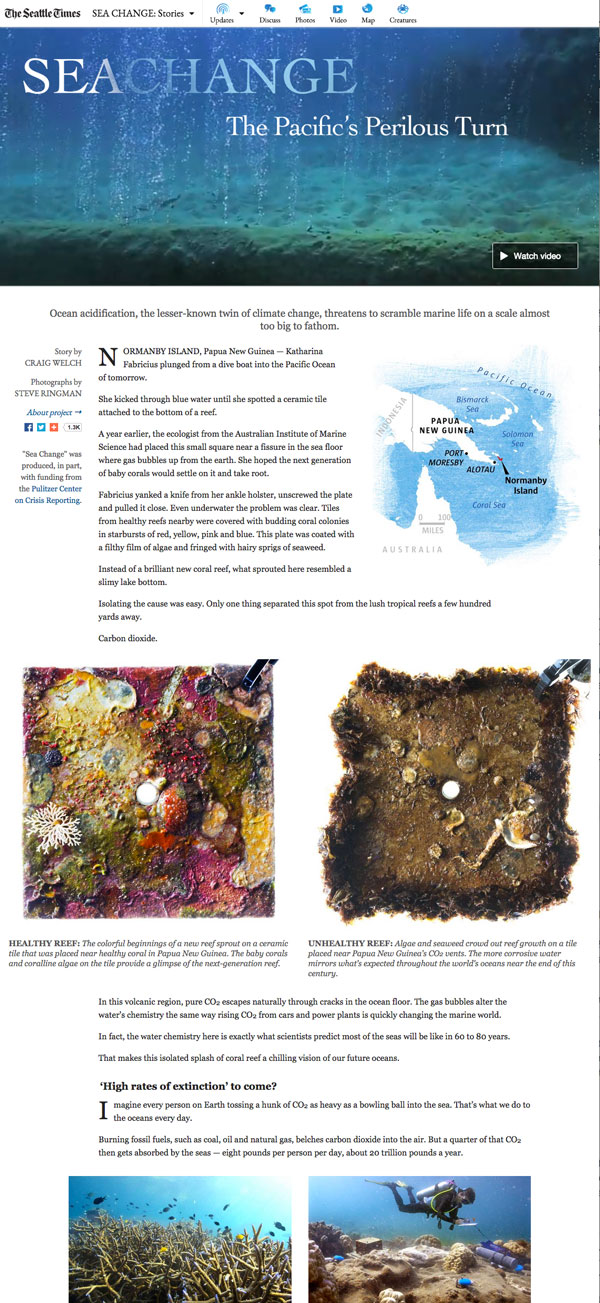
The Bill Lane Center for the American West, Stanford University

Prize Winner Q&A: “Sea Change” a Story Driven by Collaboration
Interview by Phuong Ly for the Knight-Risser Prize
Reporter Craig Welch and photojournalist Steve Ringman traveled to four states and two countries and interviewed about 150 people for their project on how the rapid rise in ocean acidification could have a disastrous effect on the sustainability of sea life. But the heart of the “Sea Change” project, the 2014 winner of the Knight-Risser Prize for Western Environmental Journalism, was much closer to home – their relationship with each other. Their collaboration, they say, drove the story from the time the idea was being formed to the final editing process.
Welch and Ringman talked constantly about the project, sharing suggestions and ideas. And they watched each other’s backs, literally. Both learned how to scuba dive and depended on each other for safety checks as they explored the seas near Papua New Guinea and Indonesia. Once, Welch spotted a poisonous octopus floating near Ringman.
The collaboration resulted in a deeply reported, visually stunning multimedia project. Such partnerships are not unusual in the best environmental journalism. Reporter-photographer teams have won half of the Knight-Risser prizes. Ringman has won the award twice, with Welch this year and in 2009, with Seattle Times reporters Hal Bernton and Justin Mayo for a project that linked logging permit practices in Washington state to the devastating impact of a storm.
Welch and Ringman shared their tips for productive collaboration:
Start working together at the very beginning.
Craig Welch: The most important part of a good writer/photographer team is collaborating from beginning to end. Before we start stories, we talk about ideas and access: Where are the places we could go? What could we see? Would that be the best way to get both compelling text and images? We both do advance research and compare notes.
Steve Ringman: Often a writer will work for months making hundreds of calls and hundreds of hours of web searches before piecing together a story. I’ve seen it more than once with our I-Team (Investigative Team) here at the Seattle Times where after a year of investigation, the editors say “we need some photos.” Often there are evidence photos, victim photos, bad quality stuff cobbled together. But what you want are active images of real people doing real things pertaining to that story and that takes lots of planning and looking ahead.
Understand and respect the other person’s needs.
Ringman: Talking together about the story all the time is key -- in the car, before the interview, the night before, during the interviews or filming. Don’t ever be offended to try something that a reporter suggests. Likewise, always ask a few questions during an interview that the reporter doesn’t ask.
The best writers communicate, they get up early with you to get the good light, they don’t mind hanging around on scene to get something a bit better. … They will sleep on ice in the Bering Sea in a tent holding a gun for polar bear protection. And watch a photographer’s back when diving at night. Just to get along and drink beer and work our asses off are all key, too.
Welch: Truthfully, all I need from a photographer is a willingness to be open and clear about how I can help them get what they need, because their needs often have to take precedence.
For most assignments, for example, I want to be able to go back and write about a scene that I've witnessed, so I'd prefer to be doing interviews in the field. But the photographer HAS to get it in the field. So, often, my needs have to be subservient. If everything goes to hell, I frequently can at least call sources once I'm back home.
Shooters get one chance, and if we're truly a team, it's just as much my responsibility as theirs to make sure they've got the best possible shot. Because no matter how compelling a story I write about changing ocean conditions, it's Steve's images they'll notice first, and they may determine immediately how much time or energy they're willing to invest in reading my words.
Be open to your partner’s suggestions.
Welch: With “Sea Change,” I would often be interviewing someone, asking loads of scientific or technical question and then turn to Steve, who would chime in with a few simple observations or more general queries that would elicit the source's best answer of the day. He's always thinking about what I'm missing for the story and then finding a way to get that big-picture question answered.
Ringman: Photographers shouldn’t be offended to try something a reporter suggests. There is an old-school attitude where photographers do their job and a reporter does his or hers. Welcome to 2015. We are in a world of journalism now where the lines are blurred and should be. All journalists now have to think, make judgments on story direction, and have good story ideas and execution. We can’t just sit on our thumbs and wait for an assignment. That’s why I like working with a writer as a team on location.
We are a family thrown together to communicate to the public. Why not start by communicating with each other?
Meet the Journalists: Attend the Knight-Risser Prize Symposium
To learn more about the reporting that led to the 2014 Knight-Risser Prize winning story, "Sea Change," sign up to attend the award presentation and symposium at Stanford University on February 25:
2015 Knight-Risser Prize Symposium: Facing the Threat of Ocean Acidification
Wednesday, Feb. 25, 2015,
4:15-6:30pm
Stanford University
The Knight-Risser Prize for Western Environmental Journalism is a joint venture of the John S. and James L. Knight Foundation, the John S. Knight Journalism Fellowships at Stanford and the Bill Lane Center for the American West at Stanford.
The John S. and James L. Knight Foundation supports transformational ideas that promote quality journalism, advance media innovation, engage communities and foster the arts. The foundation believes that democracy thrives when people and communities are informed and engaged.
The John S. Knight Journalism Fellowships is an ambitious catalyst for journalism innovation, entrepreneurship and leadership. Fellows spend their year absorbing knowledge, honing skills and developing journalism prototypes. They leverage the resources of a great university and Silicon Valley while learning from rich interactions with journalists from around the world.
The Bill Lane Center for the American West is dedicated to advancing scholarly and public understanding of the past, present, and future of western North America. The Center supports research, teaching, and reporting about western land and life in the United States, Canada, and Mexico.
Welch and Ringman talked constantly about the project, sharing suggestions and ideas. And they watched each other’s backs, literally. Both learned how to scuba dive and depended on each other for safety checks.

“We are a family thrown together to communicate to the public. Why not start by communicating with each other?”
- Steve Ringman
Texas Tribune, ProPublica

The Desert Sun and USA Today

CPI, InsideClimate News, The Weather Channel

The Seattle Times

The Sacramento Bee

High Country News

5280 Magazine

Seattle Post-Intelligencer

What Went Wrong?
The Seattle Times

San Antonio Express-News

The Los Angeles Times

High Country News




